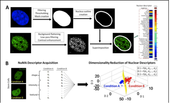Highlight
Prefiguration of Stem Cell Phenotypes using High Dimensional Nuclear Organization.
Achievement/Results
Stem cells are dynamically influenced by a wide range of microenvironmental cues during lineage commitment. Understanding this process is a major challenge in engineering a niche that instructs stem cell functions. IGERT research by trainee Sebastian Vega and co-author Er Liu stem from a collaboration between the Moghe, Becker (NIST, U. Akron), Sung (Vanderbilt), and Kohn labs. These investigators report that early analysis of cell nuclear components at 72 hours post-seeding enables forecasting long-term (~3 weeks) phenotypic changes of stem cells. Using high resolution images of nuclear proteins (e.g. nuclear mitotic apparatus (NuMA)), sets of quantitative cellular descriptor data were obtained through imaging-based feature extraction. Nuclear feature dimensionality reduction and classification methods were applied to generate combinations of descriptors that define the nuclear state of different cell populations. These data sets of early nuclear features were then used to discern changes in the stem cell lineage in response to different extracellular milieus. This approach was applied to identify and predict the commitment of human mesenchymal stem cells (hMSCs) towards osteogenic and adipogenic lineages versus a naïve, undifferentiated state. Further utility of this platform was demonstrated by forecasting the onset of cancerous transformation of stem cells and to distinguish antigentically identical precursor cells originating from different regions of the rat brain. A manuscript is currently submitted to Nature Methods on this area for review and possible publication.
Address Goals
Despite a growing understanding of the role of nuclear organization in stem cell reprogramming, quantitative approaches to profile nuclear morphological changes during stem cell phenotypic variations have not been forthcoming. Thus, the IGERT nugget highlights a major “discovery” advance in the area by using high dimensional biology of the nuclear organization of molecules such as nuclear mitotic apparatus molecule (NuMA). These molecules are also involved in chromatin remodeling, hence these tools may be potentially meaningful for elucidating possible epigenetic changes in stem cells as well.
The use of high content imaging and profiling of stem cells could be developed as a high throughput screening method for various microniche conditions for stem cell self-renewal, differentiation, or transformation. The tools developed in the IGERT program are also being widely disseminated in a number of collaborations (for example, with University of Glasgow, UK; University of Chicago; Purdue University, MIT, etc.), and being used as an educational tool for training graduate students and postdoctoral researchers.






